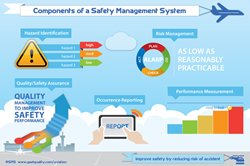Annex 19 – The Next Steps in Proactive Safety Management
By Danielle Kelly
 For the first time in 30 years, ICAO are set to release a new Annex – Annex 19 – that pulls together current safety management practices and future expectations for facilitating safety risks that exist in our lands and skies.
For the first time in 30 years, ICAO are set to release a new Annex – Annex 19 – that pulls together current safety management practices and future expectations for facilitating safety risks that exist in our lands and skies.
The Annex looks to promote and enhance the alignment between the state and service providers and operators, which in my opinion should be welcomed and can only be a positive thing. Sharing and learning from each other is good, it’s what we are taught as kids and is something we would do well to remember as adults. ICAO have provided us with Annex after Annex of standards and regulations depicting how things should be done in the industry, with lots of references to safety for operation of aircraft, air traffic services, aerodromes, and airworthiness. This new Annex brings together all of these different provisions to further embed safety oversight and systemic risk sharing, but shouldn’t we be doing this already anyway?
There is a lot of emphasis on the management of safety risks, focusing on what we don’t want to happen, and on the sharing of information. However, how worthwhile the sharing of information actually is depends on what is done with it. ICAO appear to be providing an answer to bridging the gap between simply being aware of other industry incidents and proactively managing and implementing further mitigation strategies to prevent the same thing from occurring on our own watch. But why has it taken a new Annex to be published for us to do this, shouldn’t this be something we should be doing as part of working practice? How do organizations learn and share?
It seems ICAO have produced this Annex to show that it is no longer acceptable just to Prevent, Detect and Respond; we need to be able to learn and share information, particularly as the demand for air travel increases. To that end, ICAO has offered greater support for the next generation of safety management systems. The co-ordination effort being established between State Safety Programs (SSP) and the SMS provides an opportunity to improve the performance of the existing SMS to meet state safety policies and objectives, state safety risk management, assurance and promotion.
Like I said before, we can no longer be seen just to be preventing, detecting and responding to occurrences. Learning isn’t just about reporting, understanding, implementing and then backtracking; it’s much more than that – learning is the sharing of knowledge and information, so let’s get more information about our controls instead of the outcomes. How about we manage the precursor and build our resilience?
Now, it’s all very well saying this but how do we actually achieve it?
Well, we need to start somewhere…so how about our controls? Do we have confidence in our controls? If not, why not? And what do we do about it to make sure we are confident in the controls in place?
Yes, States play a role to establish and prescribe a State Safety Program in order for us to achieve an acceptable level of safety. However, it is up to the service providers and operators who fundamentally need to demonstrate and actively manage risk and the effectiveness of mitigation strategies through their own Safety Management Systems.
So, where do we go with Annex 19?
Well, we have to make time to look at what we’ve got; we know an SMS will give us the means to do everything we need to do and to be able do them effectively in terms of manage hazards and associated risks, log incidents and occurrences to be able to report on performance. There will no doubt be policies and procedures with associated workflows that are required to be followed to ensure the investigation is appropriately dealt with.
With Annex 19, we need more than this. We need a platform to not only do all the things we need to do, but also all the things we want to do; such as anticipating and predicting, strengthening our position and giving us confidence in our controls. Because if we’re not doing that…well…in the eyes of Annex 19…are we doing it wrong?
